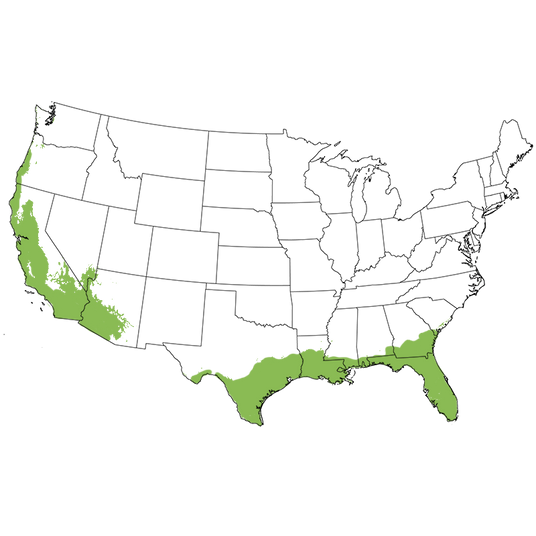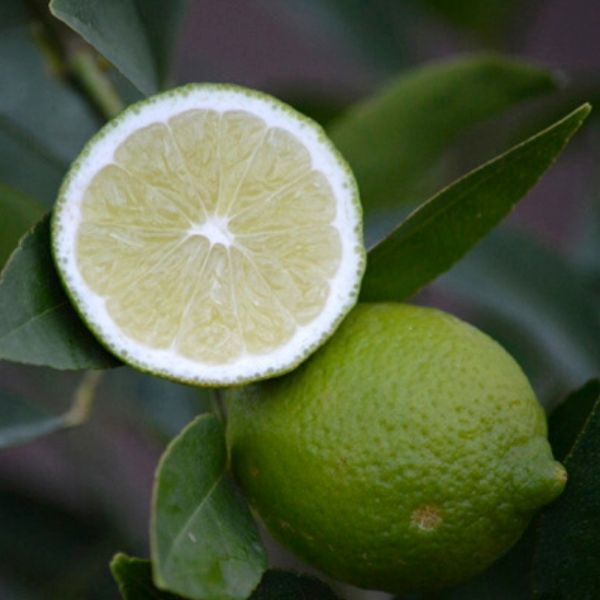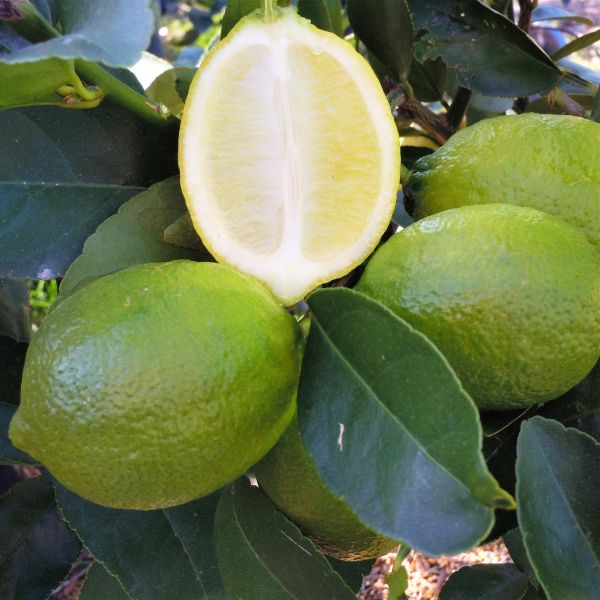Bearss Lime Tree
Citrus aurantiifolia 'Bearss'
Plant Sentry™
Plant Sentry™

Plant Sentry™ Protected
Your order is protected by our compliance system that:
- Prevents restricted plants from shipping to your state
- Ensures plants meet your state's agricultural requirements
- Protects gardens from invasive pests and diseases
Delivery and Shipping
Delivery and Shipping
Delivery and Shipping
Fast, Safe Plant Delivery
Ships in 3-4 business days • Tracking provided • Weather protected
| Under $50 | $9.99 |
| $50 - $99.99 | $14.99 |
| $100 - $149.99 | $16.99 |
| $150 - $198.99 | $24.99 |
| $199+ | FREE |
✓ Zone-specific timing • ✓ Professional packaging • ✓ Health guarantee
Understanding Plant Options
Nature Hills offers plants in two main formats:
- Container Plants: Grown in pots with soil, sized by container volume and plant age
- Bare Root Plants: Dormant plants without soil, sized by height measurements
Container Plant Sizes
Container sizes indicate plant age and growing capacity rather than liquid volume equivalents. Our containers follow industry-standard nursery "trade gallon" specifications, which differ from standard liquid gallon measurements.
Young Plants (6 months to 18 months old)
| Container Size | Actual Volume | Metric Equivalent |
|---|---|---|
| 2" x 2" x 3" | 0.18 - 0.21 dry quarts | 0.20 - 0.23 dry liters |
| 4" Container | 0.31 - 0.87 dry quarts | 0.35 - 0.96 dry liters |
| 4.5" Container | 0.65 dry quarts | 0.72 dry liters |
| 6" Container | 1.4 dry quarts | 1.59 dry liters |
| 1 Quart | 1 dry quart | 1.1 dry liters |
| 5.5" Container | 1.89 dry quarts | 2.08 dry liters |
Established Plants (18 months to 2.5 years old)
| Container Size | Actual Volume | Metric Equivalent |
|---|---|---|
| 2 Quart | 2 dry quarts | 2.2 dry liters |
| #1 Container | 2.26 - 3.73 dry quarts | 2.49 - 4.11 dry liters |
| 5" x 5" x 12" | 3.5 - 4.3 dry quarts | 3.85 - 4.74 dry liters |
Mature Plants (2-4 years old)
| Container Size | Actual Volume | Metric Equivalent |
|---|---|---|
| #2 Container | 1.19 - 1.76 dry gallons | 5.24 - 7.75 dry liters |
| #3 Container | 2.15 - 2.76 dry gallons | 8.14 - 12.16 dry liters |
Large Plants (3-5 years old)
| Container Size | Actual Volume | Metric Equivalent |
|---|---|---|
| #5 Container | 2.92 - 4.62 dry gallons | 12.86 - 20.35 dry liters |
| #6 Container | 5.25 - 6.01 dry gallons | 23.12 - 26.42 dry liters |
| #7 Container | 5.98 - 6.53 dry gallons | 26.34 - 28.76 dry liters |
Bare Root Plants
Bare root plants are sold by height from the root system to the top of the plant. Plants may exceed minimum height requirements.
Common Sizes:
- Trees: 1 foot, 2 feet, 3 feet, 4 feet, 5 feet, 6 feet
- Shrubs & Perennials: 1 foot, 18 inches, 2 feet
Important Notes
Container Volume Specifications
- Trade Gallon Standard: Our containers follow industry-standard "trade gallon" specifications established by the American National Standards Institute (ANSI Z60.1) for nursery stock
- Volume Variations: Actual soil volume may vary due to plant root systems and growing medium settlement
- Age Indicators: Container size primarily indicates plant age and maturity rather than liquid volume equivalents
Growing Conditions
- Plant size can vary based on variety and growing conditions
- Container size helps indicate plant maturity and establishment level
- Larger containers generally mean more established root systems and faster landscape establishment
Seasonal Availability
- Bare root plants are available seasonally when dormant
- Container plants are available throughout the growing season
- Specific varieties may have limited availability in certain sizes
Questions?
For questions about specific plant sizes or availability, please contact our plant experts who can help you choose the right size for your landscape needs.

Plant Sentry™ Protected
Your order is protected by our compliance system that:
- Prevents restricted plants from shipping to your state
- Ensures plants meet your state's agricultural requirements
- Protects gardens from invasive pests and diseases
Plant Profile & Growing Essentials
Evergreen, Fast-growing, Flowering, Fragrant, Self-pollinating, and Edible
Specifications
Specifications
-
Botanical Name
-
Height
-
Width
-
Growing Zones
-
Sunlight
-
Growth RateModerate
-
Flower Color
-
Leaf Color
-
Pollinator FriendlyYes
-
Pollinator Required
-
Bloom PeriodLate Spring
-
FragrantYes
Planting & Care Instructions
Planting & Care Instructions

Growing Zones 9-11 (patio 4-11)
Have easy-to-grow Limes at the ready with Bearss Lime Tree! The Bearss Lime Tree (Citrus aurantiifolia 'Bearss') is a broadleaved evergreen tree that produces fantastic Limes. Also known as a Persian Lime Tree or Tahiti Lime, looks equally charming as a patio plant to move indoors to protect from chill and freezing or as a small specimen tree in a sunny spot in your yard.
Well-known as a heavy producer, this dense, shrubby tree grows into a beautifully full crown. A fast-growing tree, the Bearss Lime has the heaviest saturation of fruit occurring during the winter and early spring in warmer regions.
Dark-green evergreen foliage offsets the beautiful, fragrant, white flowers that shine in the springtime. It presents a beautiful backdrop for the developing fruit. You'll be thrilled to watch the bright green rind take on a gentle yellow blush when it is fully ripe.
Bearss Limes have a long shelf life and are prized for their uses in a large variety of drinks and culinary dishes. Some people even use the leaves for culinary and decorative purposes as well.
Today, the Bearss is the most widely planted Lime selection. It produces fruit that has a smooth rind with green, juicy, lemon-sized fruit.
How to Use Bearss Lime Tree In The Landscape
If you live in a colder climate, no problem! Just plant Bearss Lime in containers and bring them indoors in winter. Give your tree a sunny spot to reside near a full-sun window. You'll be charmed by the invigorating Citrus scent that lifts the mood in your home during those cold winter days.
This tree is highly regarded as a small container plant and can be pruned to maintain the plant to almost any size needed. Outside in growing zones where there is no winter freeze, Bearss trees are somewhat variable in size depending upon the conditions, but make a great privacy hedge or lovely ornamental accent and specimen.
Growers appreciate the Bearss's ornamental look and the heavenly-scented floral blooms that dazzle in a beautiful white and purple show each season.
A self-pollinating fruit tree, the Bearss Lime develops its fruit early on in life, so you don't need to wait long after planting to expect the first harvest!
- Green, Juicy Limes
- Fruits Early in Age & Produces All Year
- Nearly Thornless Ornamental Evergreen
- Fragrant White Flowers
- Smaller Form But High Yield
- Great Container Plant & Wonderful Patio Trees
#ProPlantTips For Care
All Citrus do best in full sun, at least 8 hours a day for the best flowering and therefore best harvest! Indoors, you can supplement lighting with LED grow lights to extend the sparser hours of sunlight you'd naturally receive in winter.
Bearss, like all Citrus, benefit from having soil on the drier side, and soggy soil is their death. Not particular on soil type, it must be well-drained and slightly acidic to keep the root system happy. Citrus trees prefer an acidic soil mix, select a potting soil that is used for Azaleas, Camelia, or Rhododendrons. Add a quarter-inch of bark or pathway bark at the rate of 25% of the total volume of the container. This improves both the porosity and adds large-particle organic matter to the soil.
Feed your container Citrus quarterly with an acid fertilizer like Dr. Earth Acid Lovers Organic Fertilizer. Outdoors, fertilize at least 3-4 times a year as well.
Protecting Container Citrus From Cold
The natural habitat of this Citrus variety would suggest it is a prime candidate for successfully growing and cropping in marginal Citrus areas. This is also true wherever Citrus trees are brought indoors during the wintertime.
If you're growing these tropical trees in the ground in the lowest of their favored growing zones, they need to be planted in a sheltered spot to avoid the worst of the chill. If a spot like that is unavailable then you are better off planting in a large, deep container.
In border-line growing zones, begin slowly acclimating your tree indoors or into a protected location, eventually moving your tree inside in bright indirect sun for the winter if the temperatures in your area ever dip below that 40°F range. In spring, reverse this process and begin acclimating your tree to again be back out in the full sun all summer. This reduces stress and leaf drop.
- Sun Loving Citrus
- Low Moisture
- Must-Have Well-Drained Acidic Soil
- Prune Early Spring
- Appreciates Regular Fertility
Look no further if you've been seeking an indoor/outdoor Lime tree variety that boasts high production and excellent fruit! This nearly thornless Bearss Lime tree won't disappoint! Order yours from Nature Hills Nursery today!
Delicious, With a Mysterious Past
The Bearss Limes popularity is due to its wide adaptability. But it's real name is still not clearly understood. Known by several different names the Persian Lime, the Tahiti or Tahitian Lime, the USDA No.1 or 2 and the Bearss Lime, most today agree that they in fact quite similar, if not the same varieties.
The Persian Lime (Citrus x latifolia) traces itself to Asia and was most likely spread through the old Persian Empire. Some believe this to be either a cross between a Citrus aurtantifolia (the Key Lime) and Citrus medica (the Citron). Others believe that the cross is the key lime with an unknown lemon selection.
The Persian Lime is seedless for the most part and the few seeds produced often do not come true to type. The cross may have changed many times and today it is still hotly debated.
The Persian Lime is seedless for the most part and the few seeds produced often do not come true to type. The cross may have changed many times and today it is still hotly debated.
The Bearss Lime originated about 1895 in the hands of T. J. Bearss, a nurseryman in Porterville, California. Thought to have originated as a seedling from a Persian Lime, the Bearss was offered by the Fancher Creek Nursery of Fresno, California beginning in about 1905.
Although the Persian Lime had been grown for many years in Florida, the Bearss found its way to the Florida growers as well and for some time was grown side by side. Only in more recent years have the 2 varieties been considered very similar, if not the same.
Today, the Bearss is the most widely planted Lime selection. Now, it's propagated by grafting or budding so the variety remains consistent.












